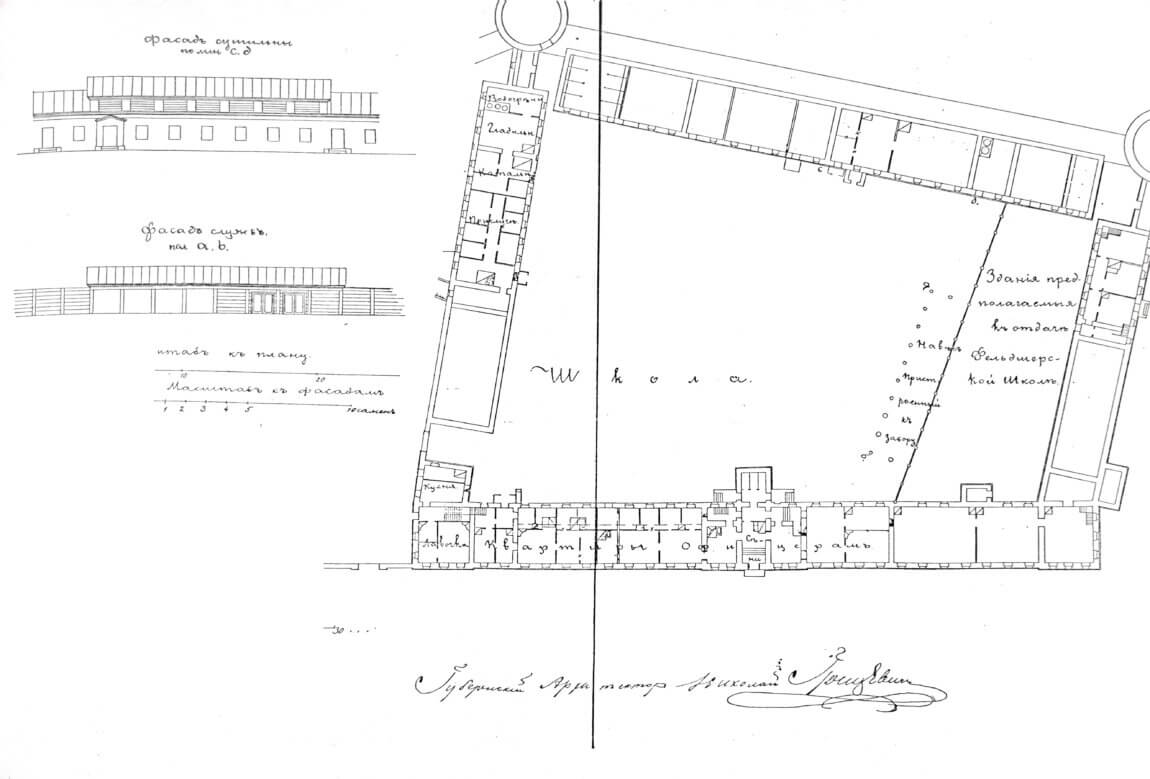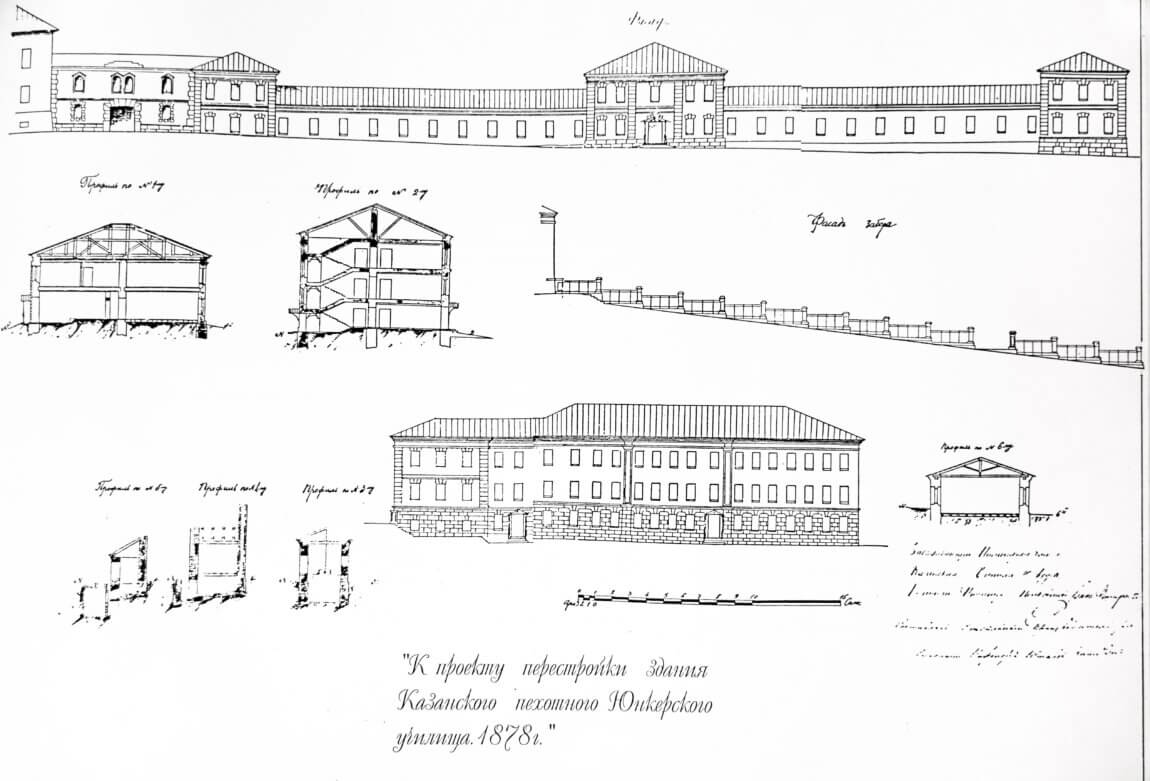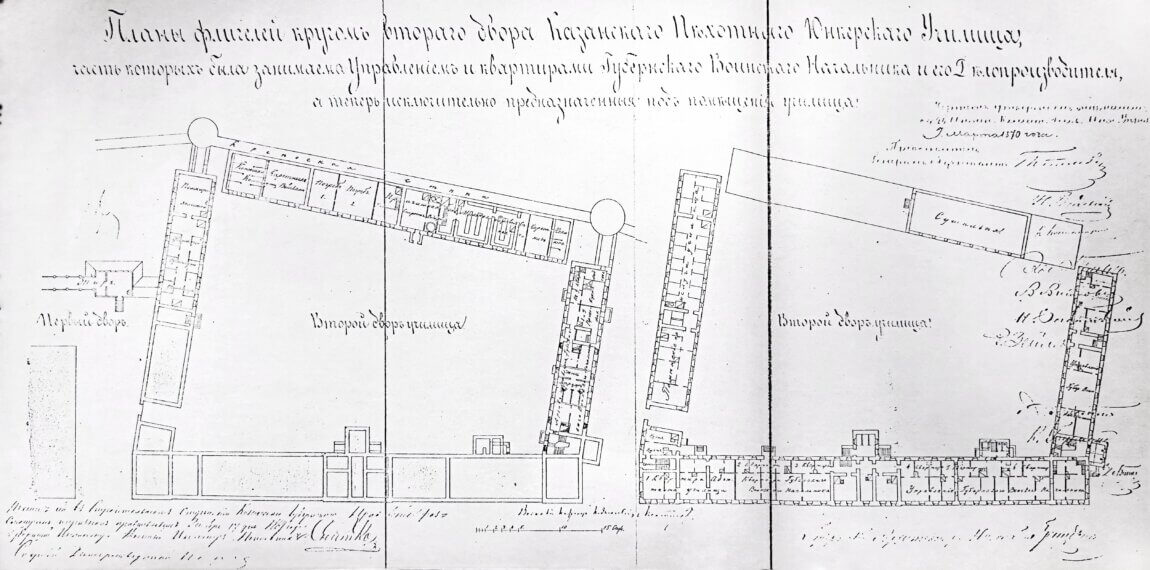Комплекс зданий Пушечного двора в Казанском Кремле имеет более чем 300-летнюю историю. XX век в истории этого архитектурного комплекса не менее интересен, чем история предыдущих столетий, когда в этом месте функционировало артиллерийское производство. Выставка знакомит с историей комплекса Пушечного двора в XX веке, а также с этапами реставрации зданий комплекса.
Выставка демонстрирует фотографические и текстовые материалы из фондов Музея-заповедника «Казанский Кремль», а также архивные материалы и материалы, присланные в ходе публичного сбора у жителей и гостей Казани, организованного в рамках подготовки выставки.

На рубеже XIX–XX веков комплекс Пушечного двора Казанского Кремля находился в ведении Казанского военного училища.
Известно, что ещё в 1866 году здания Артиллерийского двора были переданы под вновь открывшееся Казанское юнкерское пехотное училище. Проект приспособления этих зданий под учебное заведение был составлен губернским архитектором Николаем Грицевичем. Комплекс Пушечного двора становится вторым двором юнкерского училища.
В 1878 году в связи с увеличением количества учащихся юнкерского пехотного училища разрабатывается новый проект по его расширению. Проект составлен военным инженером, штабс-капитаном Федоровым. В соответствии с этим проектом в зданиях второго двора училища делаются пристрои к офицерскому флигелю, к службам. При этом северный корпус флигеля надстраивается. Кроме того, между главным зданием юнкерского училища и офицерским флигелем сооружаются двухэтажные проездные ворота. Подвергаются переработке и фасады зданий.

Согласно «Плану флигелей кругом второго двора Юнкерского училища в г. Казани 1870г.» в Главном (Восточном) корпусе двора располагались: управление губернского воинского начальника, квартира адъютанта училища, квартира губернского воинского начальника, кухня. На верхнем этаже главного корпуса находились квартиры офицеров. Северный корпус также занимало управление губернского воинского начальника (архив управления, квартиры, кухня). В западном корпусе находились конюшня, каретник, погреба, прачечная, сушильня, баня. Южный корпус занимали помещения для холостой и женатой прислуги училища, на верхнем этаже – квартира женатого офицера.
1 сентября 1909 года Казанское юнкерское пехотное училище было переименовано в Казанское военное училище, которое было расформировано 6 ноября 1917 года.

В 1919 году на базе Казанского военного училища были созданы Первые Казанские мусульманские пехотные командные курсы. В ходе ряда расформирований и реорганизаций в марте 1941 года приказом Наркома обороны СССР было образовано Казанское танковое училище. Вновь образованные учебные заведения дислоцировались в комплексе зданий бывшего Юнкерского училища.
В годы Великой Отечественной войны Казанское танковое училище занимало половину территории Казанского Кремля. В комплексе Пушечного двора располагались столовая, кухня, продовольственный склад, квартира начальника и квартиры командного состава училища.
В послевоенное время территория Артиллерийского двора некоторое время находилась в ведении танкового училища, затем до 1993 года здесь размещалась воинская часть.
За годы дислокации на территории Пушечного двора воинской части архитектурный облик зданий серьезно пострадал: дворовый фасад Главного корпуса был сильно изменен пристройками, ржавыми металлическими лестницами, огромным количеством проводов. Окна первого этажа южного крыла, где была солдатская столовая, были растесаны и заложены стеклоблоками, стены изнутри были пропитаны прогорклым жиром, в центральном ризалите располагался «Татптицепром», в северном крыле размещались продуктовые склады.
Южный и Западный корпуса использовались соответственно под административное здание с овощехранилищем и склады интендантских вещей. Здание Южного корпуса пострадало менее всего, здесь были оштукатурены внутренние стены подвального помещения, относящегося ко времени возведения комплекса. Западный корпус был надстроен вторым этажом.
Кроме того, в декабре 1993 года в торце Западного корпуса Пушечного двора произошел провал, вызванный нарушением естественных гидрогеологических процессов из-за бессистемного водопользования, что фактически поставило под угрозу сохранность корпуса и прилегающих к нему стен и башен.
После вывода в 1993 году из Казанского Кремля воинской части, занимавшей всю его западную часть, предполагалось в освободившихся помещениях Юнкерского училища и Артиллерийского двора разместить Кабинет Министров республики и его ведомства. Однако в процессе обсуждения возникла идея создания музея-заповедника и разработки концепции реставрации и музеефикации ансамбля Казанского Кремля. 22 января 1994 года Президент Республики Татарстан М.Ш. Шаймиев подписал указ о создании Государственного историко-архитектурного и художественного музея-заповедника «Казанский Кремль».
Указом Президента РТ от 13 ноября 1995 года были одобрены предложения об осуществлении первоочередных реставрационных и восстановительных работ на комплексе памятников Пушечного (Артиллерийского) двора, Губернаторского дворца и Благовещенского собора. Основные ремонтно-реставрационные работы на объектах Пушечного (Артиллерийского) двора проводились в 1995-2005 годах фирмой «Татинвестгражданпроект» и югославской фирмой «Прогресс».
В 1995-2002 годах была проведена реставрация Главного корпуса Пушечного двора по проекту архитекторов Ф.М. Забировой, Р.М. Забирова, Л.Ш. Сайфуллиной, С.П. Шакурова, А.К. Даишевой. В ходе реставрационных работ в 1995 году в южном ризалите была обнаружена литейная яма для изготовления пушек и поддувало к литейной печи.
В 2017 году литейная яма была музеефицирована и сегодня доступна для осмотра. Также, по словам архитектора Р.М. Забирова, при реставрации Главного корпуса «присутствовало много моментов архитектурной археологии», когда при снятии поздних слоев штукатурки на фасадах здания обнаруживались богатые детали, тонко, искусно вырезанные в кирпиче в XVIII веке и сбитые в XIX столетии при изменении архитектурного стиля корпуса.
Обнаружение следов этих архитектурных деталей, а также архивные изыскания, позволили архитекторам вернуть Главному корпусу Пушечного двора его первоначальный облик в стиле петровского барокко.
В 1997-1999 годах Северный корпус Пушечного двора был отреставрирован под руководством Ф.М. Забировой, архитекторы – Р.М. Забиров, С.П. Шакуров инженерная часть проекта выполнена институтом «Казанский Промстройпроект» под руководством Г.И. Никитина, архитектор – А.Х. Белостоцкая, инженер – Н.А. Имайкина, подрядные организации: фирмы ООО «Йолдыз», «Антика», «Стройсервис». Интерьеры выполнены югославской фирмой «Прогресс», архитектор по интерьерам – Петер Арсич.
Симметричная двухэтажная постройка с цокольным этажом пристроена под прямым углом к Главному корпусу Пушечного двора с севера. С конца 1990-х годов в здании Северного корпуса находились министерства и ведомства, временная резиденция президента Республики Татарстан. В настоящее время в здании размещен Представительский корпус аппарата Раиса Республики Татарстан.
Реставрация Западного корпуса проводилась в 1995-1999 годах по проекту Персональной творческой мастерской Союза архитекторов Республики Татарстан под руководством Ф.М. Забировой, архитектор – Р.М. Забиров, инженерная часть проекта выполнена фирмой «Татинвестгражданпроект» под руководством И.С. Абдрахманова, инженера А.И. Исхакова. В ходе реставрации зданию был возвращен его первоначальный облик.
Одноэтажный, протяженный корпус имел односкатную кровлю, на которую выходило 16 труб. К каждой трубе подходило по два горна. Протяженный корпус разделен на четыре секции с брандмауэрами (глухая противопожарная стена), выходящими на кровлю. В настоящее время в Западном корпусе Пушечного двора размещен Центр ремесел, ювелирный салон-мастерская, кузница с гончарной и швейной мастерскими, относящейся к палате ремесел Республики Татарстан.
Южный корпус Пушечного двора был отреставрирован в 1997-2005 годах при участии проектной мастерской Ф.М. Забировой, архитектор – С.Г. Персова, и повторяет облик здания на момент его постройки в XVII веке. В ходе реставрационных работ в корпусе обнаружили сохранившуюся систему воздуховодов, необходимых в литейном производстве по голландской технологии.
Двухэтажное здание с западной стороны примыкает к крепостной стене, а восточный торец здания заканчивается кирпичной кладкой разрушенного здания, что является свидетельством изначально П-образной формы комплекса Пушечного двора. Работы по реставрации архитектурного комплекса Артиллерийского двора окончательно завершились в 2014 году. В том же году в южном ризалите Главного корпуса был открыт Музей Пушечного двора, который продолжает свою работу и в настоящее время.